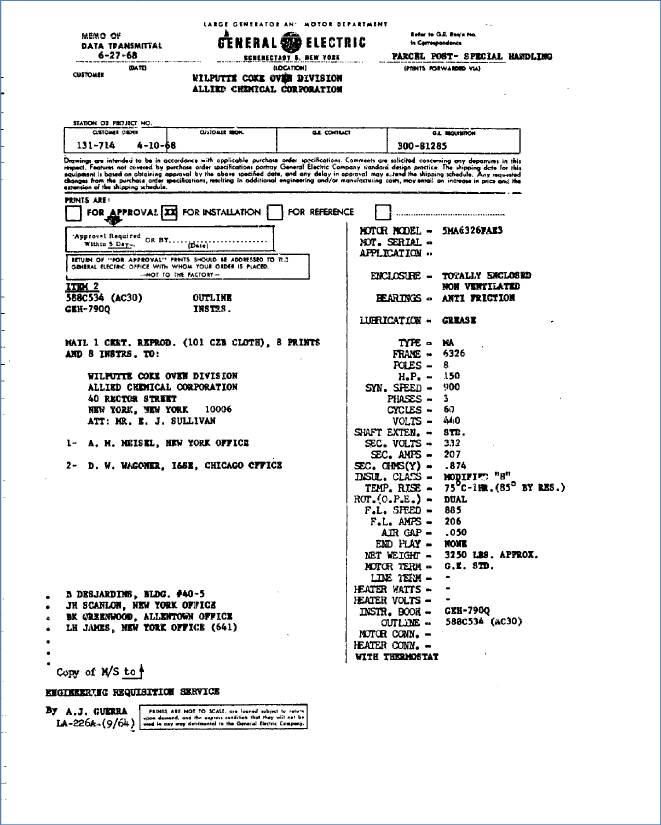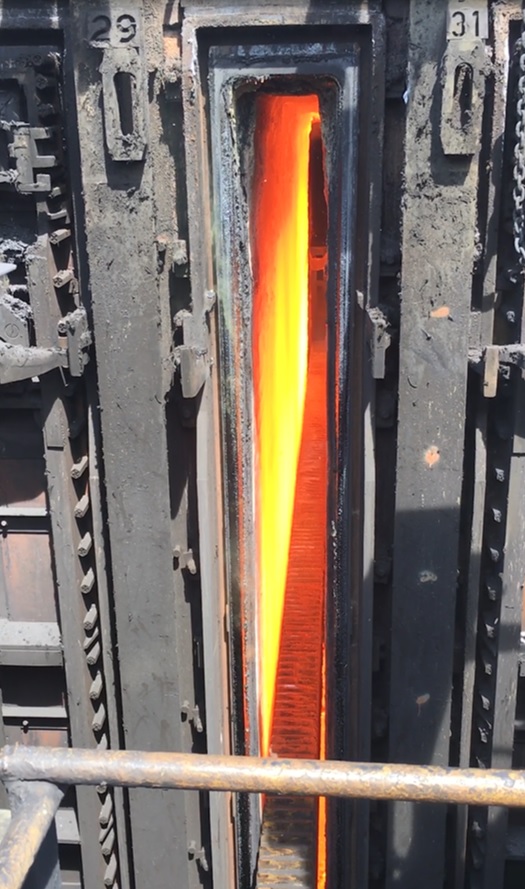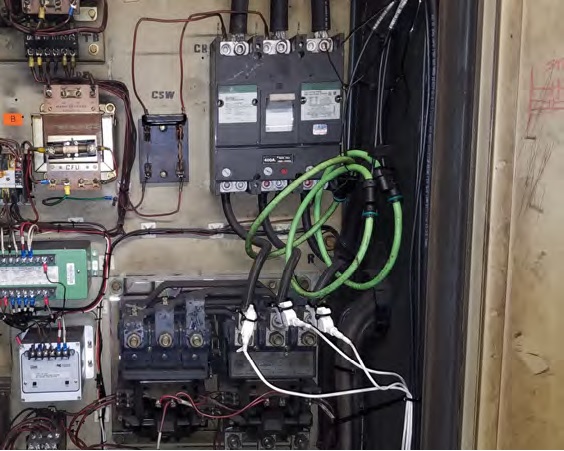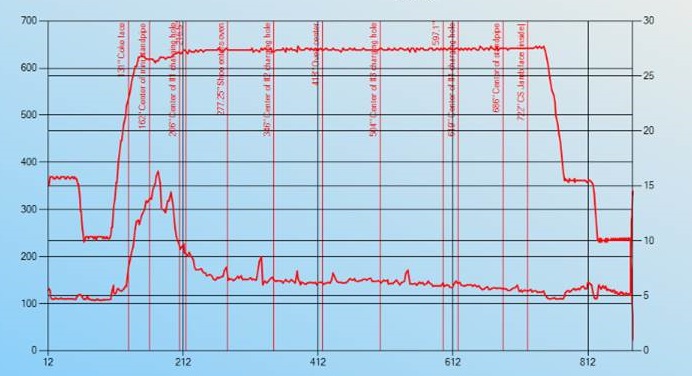“If it ain’t broke, don’t fix it” – so goes the old adage. What if ‘it’ is the drive for a massive motor used to control a pusher ram in a coke plant? Broke or not, if it does and you are unprepared, that is a whole lot of overcoked material burning away in your ovens. At some point, you just have to measure the risks, do your homework and take the plunge. The expression above is about as bad as “leave well enough alone” – a fatal cocktail with one part lack of ambition and an additional jigger of unrealistic optimism (is there any other kind?). Shake briskly and drink quickly before without thinking too deeply about what runs down your gullet. If enough good fortune is to be had, a rider on a pale horse will come into town and force the invisible hand that lashes change to the hitching post.
Acme’s pushers – and all their battery machinery – ran on DC voltage, supplied in house. In 2001 when the direct current directly ceased to be, a great migration began east of those previously employed on Torrence. They want to Indianapolis and they found their way to Gary. Many more to Burns Harbor – the last of those three which still has coke to push in 2021.
Burns Harbor’s pushers were powered by 480V three phase AC – a wildly different animal. The plant had a number of modernizations that Acme never saw. In and around the massive six meter high oven chambers of their Williputtes they could produce more coke with more ovens per battery – ovens which were rebuilt in the 80s and 90s. But behind the tall, narrow doors, somewhere beneath the beast lay a cancer. It was festering and waiting for the right moment to disable one or more of their three tank-like pushers. But just like the sorry mess at the end of the bar – call him “Hard Time Harry” – the status quo was satiated with one more cocktail (recipe above). Shaken – never stirred.
And years passed, and the pushers kept on a-pushin’. It can be hard to think out of the box when you stay in your own universe. Like an insect trapped inside a balloon – this is it’s space. Then an errant needle pops the balloon and it is thrust into that which cannot be, the hyperspace that only exists in physics manuals and some PhDs thesis. Maybe, just maybe, the guy who helped keep a more cobbled together plant running for 30 years might be willing to toss that cocktail shaker straight out the window.
In 1967 a new electrician punched in for the first time at Interlake’s coke plant on Torrence Ave. Steve Buckner was green as the rind on an August watermelon. The following year, on Rector Street some 778 miles away, Mr. E.J. Sullivan of Allied Chemical’s Wilputte Coke Oven division, recieved some drawings from General Electric. They included one for a 150hp motor that tipped the scales at a paltry ton and a half. Given that nearly 40 years later it would still be pushing thirty tons of coke from a hellish 18″ wide tunnel everyday, many times a day in fact…I’d say Mr. Sullivan chose the right documents to rubber stamp ‘APPROVED’.

But the motor was not the issue, as even decades later a suitable replacement could be dropped into the system with some ease and the endless process of clearing the ovens of their superheated offspring would continue. But motors need drives.

With the print dated 1971, this drive was no spring chicken. But before undertaking an upgrade that could take the whole pusher down, and with it a few hundred tons of over coked coal, you call in the pros to check your electrical system. Rockwell are industry leaders in drives, automation and just about anything else electrical you could come up with.
Here is an excellent synopsis of the application from the proposal to Rockwell:
The Pusher Machine ram is used to push out the coke from 6 meter ovens at the end of the coking cycle. Each oven is 20’ high, 50’ long, and 18” wide and contains 32 tons of coke. This occurs approximately every 12 minutes. The ram speed is controlled by a GE Drive. The drives were installed in 1969 on Battery 1 and 1971 on Battery 2 when the batteries were originally built. This was the best technology available at the time.

Ram travels ~878” through oven in forward direction to push coke out of oven. Process repeats every 12 mins for a duration of 1 min forward and 1 min reverse. This happens 106 times a day. Ram starts at slow speed until 104” where it goes to fast speed. This is about 2’ before making contact with the coke mass. We want ram accelerating when it makes contact with the coke face. This is where we record ‘breaking amps’. This is the peak amps to break coke mass free and start it moving. Coke oven is tapered so amps usually begin to drop off as coke is being pushed out of oven. Ram stays at full speed until reaching 739” of forward stroke and then goes to medium speed until it reaches 815” where it goes into slow speed. Slow speed continues until ram reaches forward stop limit. The reverse direction speed controls are similar except oven is empty and amps are low while ram is traveling in reverse. We have a phenomenon where ram motor stalls as coke cannot be pushed from oven. We call this a ‘sticker’. Motor goes to locked rotor amps and torque. With upgrade we need to make certain we still have the same torque available as we don’t want ‘hard pushes’ to become stickers due to lack of ram pushing force. There is also a limit to the force we apply as the oven walls are made of refractory and excessive
force can damage wall.

This 1960’s technology and the equipment has long been obsolete. We have been relying on a third party for repairs to keep equipment running. Due to the critical nature and uniqueness of this application there has been a hesitancy to replace the existing equipment as it has still continued to function. The concern is with continued sustainability.
Rockwell tapped into the existing system with their power quality analyzer and let it log data from pushes for a week.

Rockwell’s analysis is detailed in pages of graphs and tech-speak but in summation, it is quite simple: “We have noted no incoming line power quality issues that would prevent a VFD from working in this installation or present a risk of immediate damage to the VFD”
On June 26th 2018, the new drive was installed, side by side with the existing GE drive and oven #129 was pushed to great success.

A push a few weeks later was less successful but the die was cast – the new system worked and improved upon the decades old tech that had served the batteries for so long.
Objectives of the project were accomplished.
New drive pushed ovens with much improved speed control, had established a limitation on applying to much force on oven walls to protect against wall damage, and energy savings with the increased efficiencies. The drive provided reliability as it pushed 109 ovens a day for months.

The improved data collection from the drive gave a better indication of ‘hard pushes’ than the antediluvian motor drive. This provides better insights into where battery maintenance and inspections are required. The new drive is fully supported, parts and technical support are readily available providing sustainability into the future. The new drive has advanced features that can be utilized with the installation of a vfd rated motor. That motor has been received and planned to be installed in the near future. The drive would then be set up to operate in the flux vector control mode for improved speed and torque control advancing the ‘pushing of ovens’ to the current ‘state of the art’
But after it all, the system was LIVE and with far more control, ovens could be pushed once again!

